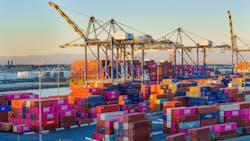Having navigated an extended post-pandemic period of rising materials prices and supply chain snarls, electrical contractors now have a fresh worry on the input cost front — this time in the form of tariffs.
President Trump’s newly announced additional 10% tariff on imports from China (beginning February 4) and the prospect of new 25% levies on those from Mexico and Canada within weeks scramble the sourcing picture for contractors. Facing another round of possible price increases on a potentially broad range of core construction inputs, the industry is growing concerned about contractual exposure, the need to find alternative suppliers, and even a slowdown in demand stemming from prohibitively high project costs.
And uncertainty — Trump decided at the last minute to hold off on imposing Mexico and Canada tariffs for at least 30 days pending border security improvements — about the administration’s plans for tariffs is at least as problematic as the tariffs themselves. Over the course of the next month (and likely beyond), contractors might have to be proactive in thinking about the consequences of costlier materials and different sourcing scenarios that could come into play. That’s a message various industry associations and construction law and advisory firms are pressing, telling contractors the risks are real.
The National Electrical Contractors Association, for one, warns in a new announcement to members that the tariffs “may introduce economic challenges for industries dependent on international supply chains, including electrical construction.” Electrical panels, copper wiring and transformers would be subject to significant cost increases, NECA says, and supply chain disruptions could spawn procurement delays impacting project timelines — a big risk for contractors working on large-scale infrastructure projects. Also, companies with fixed-price project contracts that don’t specifically account for tariffs could face financial strain, and those banking on a shift to domestic suppliers may be thwarted. “Domestic suppliers may not be able to meet increased demand, further inflating prices,” NECA stated.
In a February 3 press release, Associated General Contractors of America (AGC) said the new tariffs risked re-igniting a project cost inflation challenge that has dogged the construction industry. Tariffs, it said, are likely to spark another round of cost increases that “could impact future construction spending” and “potentially undermine future demand for projects.” Construction employers will be hurt by having to “absorb cost increases because they are locked into contracts, sometimes that were signed several years ago.”
That concern about contractual exposure is a focus of AGC member outreach. A webinar planned for late February is slated to bring together AGC counsel and construction law professionals to review tactics “to mitigate the cost and disruption impacts caused by new tariffs” in both existing and future contracts. Those might include inserting price escalation clauses, force majeure provisions, and choice of law stipulations into contracts to “fairly allocate risks among owners, general contractors, trade contractors, and suppliers.”
Taken together, the additional costs U.S. industry faces from new tariffs could be staggering, especially if tariffs on Mexico and Canada are imposed. Combined, the three countries provided about $1.3 trillion in goods to the United States in 2024.
Just from an all-encompassing electrical products standpoint, “electroindustry” goods from China, Mexico, and Canada, which includes electrical materials used in construction, could be subject to $22 billion in tariffs, according to National Electrical Manufacturers Association (NEMA). The additional 10% tariff on China alone, it says, translates to about $4.4 billion.
That number could be on the high side because there’s some evidence U.S. importers of goods from China may have gotten a jump on the new tariffs. Appearing on a Bloomberg TV program on February 6, Gene Seroka, executive director of the Port of Los Angeles, which handles nearly half of all Chinese exports to the United States, said traffic spiked above normal patterns in the latter part of 2024 — a sign that buyers were stockpiling goods ahead to get in under the wire and escape the higher levy.
While new and additional tariffs on the nation’s three largest trading partners will impact the broad U.S. economy, the blow could be significant to efforts now underway to build out critical infrastructure. Within the electrical sphere, higher costs for inputs needed to bolster and improve the electrical grid and integrate more carbon-free energy sources could slow progress. From steel for wind turbines to rare earth minerals for energy storage batteries to transformers, switchgear, and circuit breakers for power distribution, imported products are essential to that effort, and will prove hard to replace with U.S. made substitutes any time soon.
That, of course, is one of the goals of the new Trump administration push for tariff expansion: encourage the long-term development of domestic production of goods now purchased from other countries. But building that up comes with its own set of risks — chief among them locking in higher production costs that would accompany pricier labor.
But that effort to “re-shore” production is moving ahead to the benefit of the construction industry. Manufacturing is one of the hottest market sectors in domestic construction, a direct result, statistics show, of efforts to shorten supply chains and bring production closer to home. The U.S. Census Bureau says re-shoring accounted for more than $195 billion in annualized construction spending in 2023 — well far above the $60 billion average over the prior decade.
About the Author
Tom Zind
Freelance Writer
Zind is a freelance writer based in Lee’s Summit, Mo. He can be reached at [email protected].
